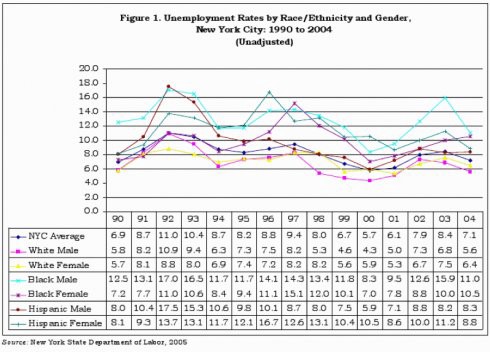Black Unemployment Reaches "Great Depression Proportions"
In the 1960s, the African-American unemployment rate in New York City was nearly identical to the white people unemployment rate. But by 1990, black people were well more than twice as likely to be unemployed as white people. Ever since, black unemployment has been the leading edge of unemployment trends; when unemployment shot up in 1992 to a New York City-wide average of 11%, unemployment among black men went to 17%. (Of course these are state Department of Labor numbers; they indicate people actually enrolled in the system, not the further mass of the jobless.) Let’s take a look at the trending since the early 90s!

Well, and: those were the good times.
When we talked about the faces of recessioning yesterday, we were mildly chafed at an in-depth look at the decline in opportunities among expected white top-earners. Today, the Washington Post takes a look at the nation’s 34.5% unemployment among African-Americans:
Joblessness for 16-to-24-year-old black men has reached Great Depression proportions — 34.5 percent in October, more than three times the rate for the general U.S. population…. Young black women have an unemployment rate of 26.5 percent, while the rate for all 16-to-24-year-old women is 15.4 percent.
In adorable form, the Post says that “Some studies examining how employers review black and white job applicants suggest that discrimination may be at play.” Oh, really?
“Black men were less likely to receive a call back or job offer than equally qualified white men,” said Devah Pager, a sociology professor at Princeton University, referring to her studies a few years ago of white and black male job applicants in their 20s in Milwaukee and New York. “Black men with a clean record fare no better than white men just released from prison.”
